IB Biology HL (HIGHER level)- 2024 – Practice Questions- All Topics
Topic 8.2 Cell respiration
Topic 8 Weightage : 13%
All Questions for Topic 8.2 – Energy Conversions, Glycolysis, Link Reaction, Krebs Cycle, Electron Transport Chain, Aerobic Overview, Mitochondria, Uses of ATP, Energy Sources, Anaerobic versus Aerobic Respiration, Phosphagen System
Question
What does electron tomography allow mitochondria researchers to do?
A To produce images of cristae.
B To produce images of ATP synthase molecules.
C To trace the movement of electrons through the electron transport chain.
D To visualize oxidation/reduction reactions.
▶️Answer/Explanation
Ans: A
Electron tomography is a technique that involves taking a series of images of a sample from different angles and then using these images to create a three-dimensional model of the sample. In the case of mitochondria researchers, electron tomography is used to produce images of cristae, which are the folds in the inner mitochondrial membrane where the electron transport chain and ATP synthase are located. By creating a three-dimensional model of the cristae, researchers can study the structure and function of the electron transport chain and ATP synthase in more detail. This allows them to better understand how mitochondria produce ATP, which is essential for cellular energy production. Therefore, option A is the most accurate description of what electron tomography allows mitochondria researchers to do.
Question
Which equation is an example of decarboxylation?
A Pyruvate ![]() Acetyl CoA + CO2
Acetyl CoA + CO2
B CO2 + H2O ![]() H2CO3
H2CO3
C CH4 + 2O2 ![]() CO2 + 2H2O
CO2 + 2H2O
D. 
▶️Answer/Explanation
Ans: A
Decarboxylation is a chemical reaction that involves the removal of a carboxyl group ($\textrm{-COOH}$) from a molecule. In the case of pyruvate, which is a three-carbon molecule produced during glycolysis, it undergoes decarboxylation to form acetyl CoA, a two-carbon molecule, and carbon dioxide ($CO_{2}$). This reaction is catalyzed by the enzyme pyruvate dehydrogenase complex. Therefore, option A is the most accurate description of an example of decarboxylation.
The image shows a portion of a cell containing a mitochondrion.
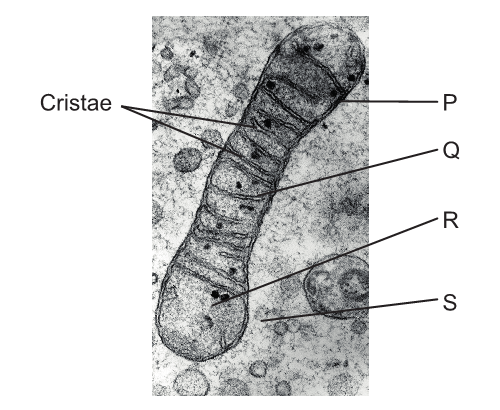
Where do glycolysis and electron transport occur?
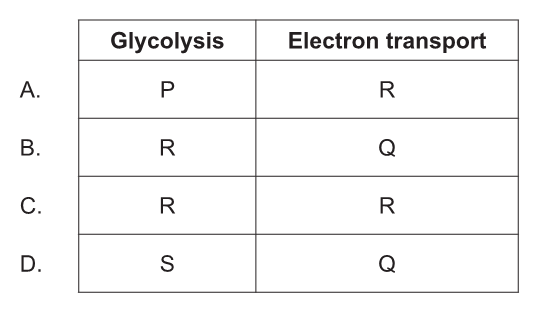
▶️Answer/Explanation
Markscheme
D
P- Outer mitochondrial membrane
Q- Inner mitochondrial membrane
R- Matrix
S- Cytoplasm
Glycolysis occurs in the cytoplasm where one 6 carbon molecule of glucose is oxidized to generate two 3 carbon molecules of pyruvate.
The mitochondrial electron transport chain (ETC) consists of five protein complexes integrated into the inner mitochondrial membrane.
Which reaction does not cause a net release of energy?
A. ADP combines with inorganic phosphate to form ATP
B. ATP releases inorganic phosphate to form ADP
C. Loss of hydrogen from reduced NAD
D. Oxidation of reduced FAD
▶️Answer/Explanation
Markscheme
A
ADP combines with inorganic phosphate to form ATP is an endergonic reaction, which means that it requires energy input to occur. Specifically, the energy required to drive this reaction comes from the breakdown of glucose during cellular respiration. Once ATP is formed, it can be used to power a variety of energy-requiring processes in the cell. In contrast, options C and D both involve the release of energy. The loss of hydrogen from reduced NAD is an example of oxidation, which releases energy, while the oxidation of reduced FAD also releases energy. Finally, option B is an example of hydrolysis, which releases energy when ATP is broken down into ADP and inorganic phosphate. Therefore, option A is the most accurate description of a reaction that does not cause a net release of energy.
This reaction occurs in mitochondria.
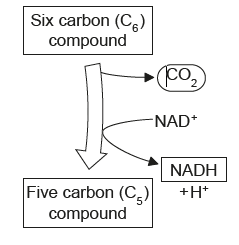
What explains that this reaction enables energy to be converted into a usable form?
A. The oxidized NAD+ will transfer the energy from the C6 compound to ATP.
B. The chemical energy stored in the C6 compound is used to reduce NAD+ allowing ATP production.
C. Energy stored in the CO2 molecule will generate an electron gradient.
D. The C6 compound is reduced and the energy resulting from the removal of one carbon is used to oxidize NAD+.
▶️Answer/Explanation
Markscheme
B
The Krebs cycle summarizes a circular series of reactions in the mitochondria to metabolize AcCoA to two molecules of $CO_{2}$ with resultant generation of one molecule of GTP, three molecules of $\textrm{NADH}$, and one molecule of $\textrm{FADH}$.
Acetyl-CoA combines with oxaloacetic acid in the Krebs cycle to form the six-carbon atom citric acid. After a quick rearrangement, this six-carbon molecule releases two of its carbons as carbon dioxide molecules in a pair of similar reactions. During this step, $\textrm{NAD}^{+}$ is reduced to form $\textrm{NADH}$.
Citric acid is successively converted to five- and four-carbon acids as carbon dioxide molecules and hydrogen atoms are split off, and the cycle finally returns to oxaloacetic acid.
The diagram shows a mitochondrion. Which letter indicates the structure where ATP synthase is located?
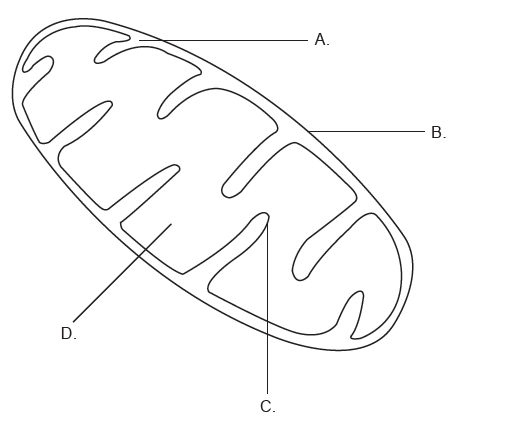
▶️Answer/Explanation
Markscheme
C
ATP synthase is located in the inner membrane of the mitochondrion. In the diagram, the structure labeled “C” is the inner membrane of the mitochondrion. The inner membrane of the mitochondrion is the site of the electron transport chain, which generates a proton gradient that is used by ATP synthase to produce ATP. ATP synthase is a large protein complex that spans the inner membrane of the mitochondrion and is responsible for the final step in oxidative phosphorylation. Therefore, “C” indicates the structure where ATP synthase is located.
Which process requires oxygen in aerobic cell respiration?
A. Oxidation of triose phosphate
B. Reduction of hydrogen carriers
C. Maintaining an oxygen concentration gradient in mitochondria
D. Accepting electrons at the end of the electron transport chain
▶️Answer/Explanation
Markscheme
D
The process that requires oxygen in aerobic cell respiration is accepting electrons at the end of the electron transport chain. Oxygen is the final electron acceptor in the electron transport chain, which is the last stage of aerobic respiration. In this process, electrons are passed through a series of protein complexes, which pump protons across the inner mitochondrial membrane, creating a proton gradient. This gradient drives the synthesis of ATP by ATP synthase. Oxygen is required to accept the electrons at the end of the electron transport chain, which allows the process to continue. Without oxygen, the electron transport chain would stop functioning, and ATP production would cease. Therefore, the correct answer is D.
Question
An electron micrograph of a mitochondrion is shown.
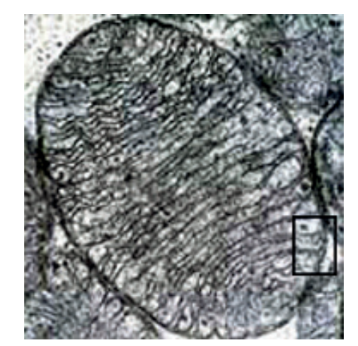
The distance between the inner and outer membranes, which are shown by the box, is always very small. What is the advantage of this small distance?
A. Enables a high concentration of electrons to build up quickly
B. Enables a high concentration of protons to build up quickly
C. Allows fast diffusion of glucose into the mitochondrion
D. Allows fast diffusion of reduced NAD out of the mitochondrion
▶️Answer/Explanation
Ans:B
